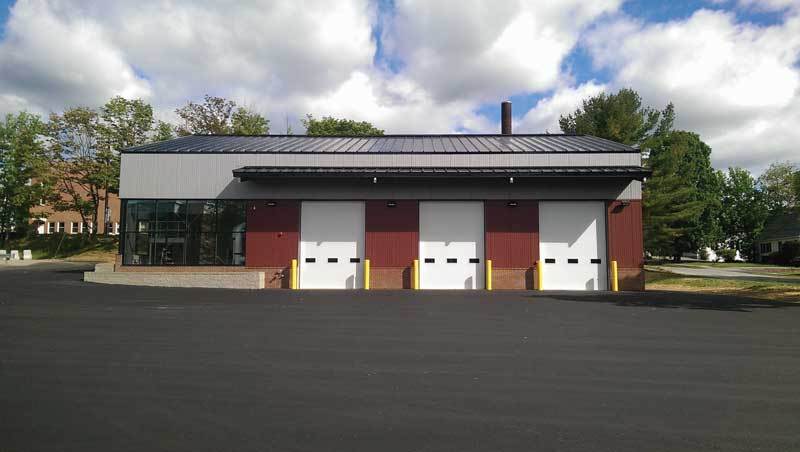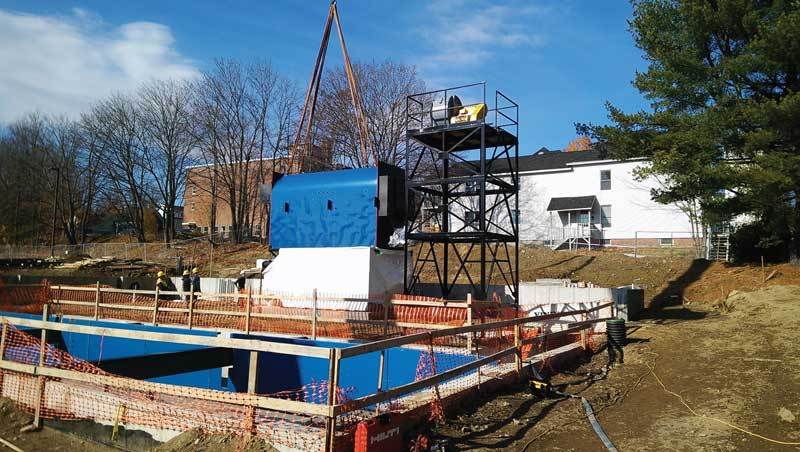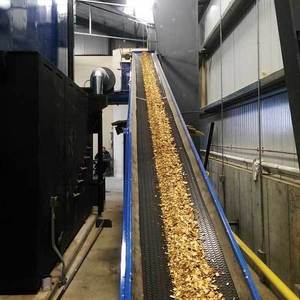Passing the Test










PHOTO: TRANE
September 22, 2016
BY Katie Fletcher
Last winter, about a mile from the small, picturesque town of Farmington, Maine, University of Maine at Farmington Director of Facilities Jeffrey McKay recalls looking over the campus and observing a single plume of steam rising into the chilly winter morning air. On a cold day just one year earlier, smoke stacks billowing into the sky were visible from 22 different collegiate buildings.
For UMF, the decision to implement a biomass district heating project was driven by a couple factors. “One reason is less volatility than the fossil fuel market, traditionally,” says Mark Power, energy services team leader with Trane and energy service contractor on the project. “In this particular case, the campus was heating primarily with oil with a little bit of propane in the mix, and they had been subject to price volatility over the years, so there was a desire to do something to reduce their operating cost.”
Not only was a more attractive economic option desired, but UMF’s mechanical plants were aging and needed replacement. “They had concerns about downtime, maintaining enrollment and providing good services to their customers who are ultimately the students,” Power says. This year, as students get back to the books, UMF will make sure they are comfortable for the chilly fall and winter months by heating their surroundings with locally sourced wood chips.
Heating oil, propane and natural gas market volatility, alongside solar and wind power intermittency, make baseload, renewable biomass an attractive option for a number of heating installations. The economic and environmental attributes of biomass have encouraged the wave of district heating projects like UMF that have sprung up across North America over the past decade. Whether fully operating, contracted or a long-term vision in mind, biomass projects particularly make sense where the resource is readily available, replacement of an older, inefficient system is needed and the institution has environmental initiatives to meet.
Carbon Neutral Campus
Power’s team at Trane installed the UMF central heating plant and fired up the boiler this past February and it was “working fabulously” for the few months it was running, McKay says. Power agrees, calling it a “technical success.” The project includes the installation of a 500 horsepower Messersmith biomass unit—equipped with a propane gas burner and gas train for backup—and approximately two miles of new underground hot water distribution system piping connecting it to a majority of the campus buildings. “It eliminated the use of all of the old heating plants,” Power says. Four existing boilers were retrofitted to serve as injection points for the hot water distribution loop. The fuel for the backups is a mix—one of the backup plants is run on propane and the other three on fuel oil. “That gives them the option during the nonheating summertime season, depending on the fuel market, they can either use propane or oil to provide their domestic hot water,” Power adds.
Trane has been involved in several major biomass conversion projects, including installing heating systems at the Maine schools of Caribou High School, Limestone Community School, Fort Fairfield Schools and Greenville High School. “This is certainly the largest biomass conversion project that Trane has been involved in, in the U.S.,” Power states. In fact, Powers says, this is the largest hot water heating plant in the state of Maine. Colby College has a plant that is larger, but it’s a combined-heat-and-power plant.
According to McKay, truck traffic decreased from 36 to 40 trucks of oil per week to just four or five trucks hauling local wood chips onto the campus. The central heating plant has an underground storage bunker that can hold about 120 tons or about three truckloads of wood chips—a four-day supply at peak load. Ash, which is raked every two to three days, is used in the campus compost program, under which it is applied to local farms and even the university’s athletic fields. The ash is applied locally from wood sourced from the campus’s own backyard. “We just went out to bid on our chips and we put in some sustainability initiatives—for example, we only want chips within a 50-mile radius of campus, and things like that, so it truly has an impact on the local economy,” McKay says. UMF contracted with Cousineaus Forest Products and spends about $250,000 per year on wood chips, which, based on the multipliers McKay has heard, has about a million-dollar impact on the local economy, plus the added reduction in carbon emissions.
Estimated annualized savings from the switch to wood chips are $800,000 per year, with a simple payback of approximately 10 years. Power says that this is why it’s such a fantastic fuel-switch opportunity, not to mention to meet the campus climate commitment to become carbon neutral by year 2035. “They weren’t meeting their own goals until this project came in and now they’ve blown their goals away,” Power says.
Since the boiler’s capacity is in excess of 10 million Btu, an electrostatic precipitator (ESP) was installed to meet the federal air standards within the U.S. EPA’s boiler MACT rule. It hasn’t been running during the summer months, as a full heat load is not needed in the summer to circulate hot water, but McKay is getting ready to fire the plant up again in late October.
Work in Progress
UMF joins a number of universities that will fire up their biomass systems, welcoming students back to campus for fall and winter studies, while others will spend this winter getting ready to break ground and go vertical. Goddard College, located on a 100-plus-year-old farmstead in Plainfield, Vermont, announced in May it will receive a $2.1 million USDA community facilities loan once it has built a biomass central heating plant. According to Tim Maker, project manager with Community Biomass Systems Inc., they are getting bids back at the end of November, and will then hire the general contractor. “We look at this as a 2017 project, so as soon as the ground thaws in the spring, we’ll start work probably around May 1,” he says. “Essentially, in the summertime most of the work will be done, and the system will become functional next fall about a year from now.” Maker adds it will take some time to get the heat load up to full capacity next winter.
This has been a long time coming for Goddard. The idea for implementing a central biomass system to heat the campus’s 23 historic buildings was first brought up in 2008, with a feasibility study following showing biomass as a favorable option. However, there was some pushback. Maker says with permits in hand, the project went out to bid in 2011, but its permits were appealed by four neighbors who felt the idea of having a biomass plant at Goddard college was an intrusion into the bucolic nature of their neighborhood. Maker adds that these sentiments were felt despite the fact Vermont has around 45 public schools, including one in Plainfield, that have biomass systems.
This battle has been ongoing for the past four years, but the project is now finally able to switch out 22 aging oil boilers with a 3 million-Btu Messersmith biomass boiler, replacing an estimated 40,000 gallons of fuel oil. “We just made the decision to use propane instead of oil for the backup and the hope is that the backup boilers will be little used,” Maker says. Goddard’s system is much smaller than UMF’s biomass heating unit, but it still chose to install an ESP for particulate matter control. “There is no federal requirement whatsoever, in fact, there isn’t even a state requirement, that doesn’t kick in until you get to boilers about 50 percent larger than the one to be used here,” Maker says. “It is really unprecedented for an institution to take on that expense, so it can be right on the cutting edge of the cleanest biomass combustion at this scale.”
Although oil prices are down, resulting in less dramatic savings than when the project was initially conceived, the college still faced an estimated $500,000 cost to replace oil boilers over the next 10 years. Besides the need for a new heating system, Goddard President Bob Kenny highlights the abundance and availability of biomass, saying that Washington County, Vermont, “has an immense amount of wood available for this enterprise.” He adds that the area is now probably along the order of 75 percent or greater covered with trees.
Maker says universities like Goddard make sense for biomass district heating projects because it’s more or less plug and play. “If you’ve already got a central system that heats all of your buildings, going into one location and adding a biomass boiler makes a lot of economic sense.” A number of Vermont institutions of higher education have installed biomass systems, but, Maker adds, economics should be evaluated from a long-term view, without the expectation of a couple-year payback.
Colleges in the U.S. aren’t the only ones taking a long-term look at biomass as a heating option. Just this summer, Simon Fraser University located on British Columbia’s West Coast completed negotiations with Corix Multi-Utility Services Inc. to finance, design, construct, own and operate a new central energy plant, burning uncontaminated wood waste such as wood chips, shavings and sawdust for heating and domestic hot water. This plant will service SFU’s Burnaby campus and the UniverCity community—a sustainable community located on top of Burnaby Mountain, adjacent to SFU.
According to Larry Waddell, SFU chief facilities officer, the community-based district energy utility uses a temporary natural gas plant, which was approved by the BC Utilities Commission in 2011, and the first customers were connected in early 2012. “While the development of the UniverCity district energy system was underway, SFU was also evaluating initiatives for potential replacement of their existing natural gas-based central energy plant that supplies thermal energy to SFU campus,” Waddell says. SFU and Corix signed a memorandum of understanding to conduct the analysis of a combined thermal energy plant that would serve both the campus as well as UniverCity. Various alternative energy sources, plant location and sizing were evaluated and the results demonstrated significant benefits to proceed with a single, central energy plant, in which, biomass energy was the most viable solution for the energy requirements.
The energy facility will be installed on the southern portion of the campus currently located on the site of an older parking and storage facility and will significantly improve the visual character of this undeveloped site. At build-out, the plant is expected to reduce campus greenhouse gas (GHG) emissions from heating by 85 percent and reduce SFU’s GHG emissions from all sources by 69 percent. These emission reductions are expected to surpass the provincially mandated GHG reduction targets for 2020 and set the university on the path to achieving B.C.’s 2050 reduction target.
A Biomass Future
While many campus biomass district heating projects are up and running, projects like Goddard’s and SFU’s are not far behind. Meanwhile, some universities are taking notes and just beginning to add biomass to their lists of options. At Oregon State University’s Cascades branch campus in central Oregon, a $193,910 grant was recently awarded by the USDA Forest Service’s Wood Innovation grant program to determine the technology and space requirements of a campus-scale biomass thermal energy system. OSU-Cascades will contribute $67,869 in matching funds toward the grant. A preliminary study already showed that a proposed woody biomass system would be technically feasible and economically viable. What sets this project apart from the others is that OSU Cascades is still being developed, and is considering biomass in the early stages. According to Jane Barker, OSU-Cascades senior project manager, this branch campus of the OSU institution started in the fall of 2001 in leased facilities on the local Central Orego Community College campus. In 2012, the decision was made to have an expanded presence in central Oregon, so they are moving to a four-year university from a two-year graduate degree granting institution.
There was a process by which they evaluated how much land they would need to potentially purchase to support a 5,000-student campus, Barker says, which determined between 45 and 65 acres would be needed. She says biomass came up as a mutually beneficial opportunity to heat the new campus. “We’re in a location very close to natural forest lands that have a tremendous amount of biofuel currently being gathered and flash burned to prevent fire hazards, and we were looking for a renewable resource to use at the campus that would support that,” Barker explains.
Currently, OSU Cascades is going through long-range development planning, according to Barker. “We’re looking at building the layout, how to phase in a system, where it would be located,” she shares. “We’ll be looking at wrapping up that phase by the end of the year, so over the next four or five months we’ll be finalizing our understanding of how we’re phasing the job in—when would that central utility plant go into place, what would be the energy source for it, how would it be sized, and so on.”
Despite the often multiyear development time-frame required of university biomass district heating projects, what makes installations like these viable at OSU-Cascades and other institutions of higher education is ample access to local biomass, sustainable- and environmental-minded academic programming and goals, as well as a long-term view on the overall economic and environmental wellbeing of the campus and student body that inhabits it.
“I think institutions of higher education are in a particularly good position to lead by example,” Kenny says. “When we take steps that are environmentally and sustainability orientated in this way, we are leading and hopefully sending a message to the next generation of leaders that there are ways to do things outside of what they think of as their norm as they experience the world.”
Author: Katie Fletcher
Associate Editor, Biomass Magazine
701-738-4920
kfletcher@bbiinternational.com
Advertisement
Advertisement
Upcoming Events





